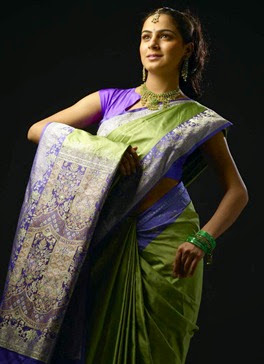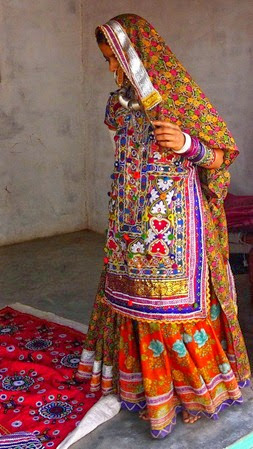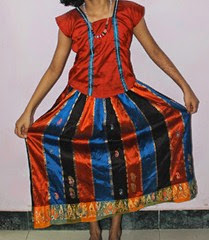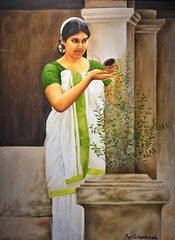History of Woman"s clothing
In India, woman's clothing varies widely and is closely associated with the local culture, religion and climate.
Traditional Indian clothing for women in the north and east are saris or ghagra cholis and (lehengas) while many south Indian women traditionally wear sari and children wear pattu langa. Saris made out of silk are considered the most elegant. Mumbai, formerly known as Bombay, is one of India's fashion capitals.In many rural parts of India, traditional clothing is worn. Women wear a sari, a long sheet of colourful cloth, draped over a simple or fancy blouse. Little girls wear a pavada. Both are often patterned. Bindi is a part of women's make-up. Indo-western clothing is the fusion of Western and Subcontinental fashion. Churidar, dupatta, Khara Dupatta, gamchha, kurta, mundum neriyathum, sherwani are among other clothes.
The traditional style of clothing in India varies with male or female distinctions. This is still followed in the rural areas, though is changing in the urban areas. Girls before puberty wear a long skirt (called langa/paawada in Andhra) and a short blouse, called a choli, above it.
Traditional clothing
Sari
 A saree or sari is a female garment in the Indian subcontinent. A sari is a strip of unstitched cloth, ranging from four to nine meters in length, that is draped over the body in various styles. There are various traditional styles of saree: Sambalpuri Saree from East, Kanchipuram from South, Paithani from West and Banarasi from North among others. The most common style is for the sari to be wrapped around the waist, with one end then draped over the shoulder baring the midriff. The sari is usually worn over a petticoat. Blouse may be "backless" or of a halter neck style. These are usually more dressy with a lot of embellishments such as mirrors or embroidery and may be worn on special occasions. Women in the armed forces, when wearing a sari uniform, don a half-sleeve shirt tucked in at the waist. Teenage girls wear half-sarees, a three piece set consisting of a langa, a choli and a stole wrapped over it like a saree. Women usually wear full sarees.
A saree or sari is a female garment in the Indian subcontinent. A sari is a strip of unstitched cloth, ranging from four to nine meters in length, that is draped over the body in various styles. There are various traditional styles of saree: Sambalpuri Saree from East, Kanchipuram from South, Paithani from West and Banarasi from North among others. The most common style is for the sari to be wrapped around the waist, with one end then draped over the shoulder baring the midriff. The sari is usually worn over a petticoat. Blouse may be "backless" or of a halter neck style. These are usually more dressy with a lot of embellishments such as mirrors or embroidery and may be worn on special occasions. Women in the armed forces, when wearing a sari uniform, don a half-sleeve shirt tucked in at the waist. Teenage girls wear half-sarees, a three piece set consisting of a langa, a choli and a stole wrapped over it like a saree. Women usually wear full sarees.
Saris are usually known with different names in different places. In Kerala, white saris with golden border, are known as kavanis and are worn on special occasions. A simple white sari, worn as a daily wear, is called a mundu. Saris are called pudavai in Tamil Nadu. In Karnataka, saris are called kupsas
Ghagra Choli (lehenga choli)
 A Ghagra Choli or a Lehenga Choli is the traditional clothing of women in Rajasthan and Gujarat. Punjabis also wear them and they are used in some of their folk dances. It is a combination of lehenga, a tight choli and an odhani. A lehenga is a form of a long skirt which is pleated. It is usually embroidered or has a thick border at the bottom. A choli is a blouse shell garment, which is cut to fit to the body and has short sleeves and a low neck.
A Ghagra Choli or a Lehenga Choli is the traditional clothing of women in Rajasthan and Gujarat. Punjabis also wear them and they are used in some of their folk dances. It is a combination of lehenga, a tight choli and an odhani. A lehenga is a form of a long skirt which is pleated. It is usually embroidered or has a thick border at the bottom. A choli is a blouse shell garment, which is cut to fit to the body and has short sleeves and a low neck.
Different styles of ghagra cholis are worn by the women, ranging from a simple cotton lehenga choli as a daily wear, a traditional ghagra with mirrors embellished usually worn during navratri for the garba dance or a fully embroidered lehenga worn during marriage ceremonies by the bride.
Popular among unmarried women other than shalwar kameez are Gagra choli and Langa voni
 Salwar Kameez
Salwar Kameez
Salwar is a generic description of the lower garment incorporating the Sindhi suthan, Dogri pajamma and the Kashmiri suthan.
The Salwar kameez is the traditional wear of women in Punjab, Haryana and Himachal Pradesh. The suthan, similar to the salwar is common in Sindh and Kashmir. The salwar kameez has become the most popular dress for females. It consists of loose trousers (the salwar) narrow at the ankles, topped by a tunic top (the kameez). It is named as "Punjabi suit" or simply "shalwar" in the north and "churidaar" in Southern India. Women generally wear a dupatta or odani (Veil) with salwar kameez to cover their head and shoulders. It is always worn with a scarf called a dupatta, which is used to cover the head and drawn over the bosom. The material for the dupatta usually depends upon that of the suit, and is generally of cotton, georgette, silk, chiffon among others. This dress is worn by almost every teenage girl in lieu of western clothes. The salwar kameez is most common in the northwestern part of India. Many actresses wear the salwar kameez in Bollywood movies.
Churidaar Kurta
Churidaar is a version of salwar, which is loose up to knees and then fits the calf below. A salwar is a baggy pyjama with pleats which gets narrow at the ankles whereas churidaar fits below the knees with horizontal gathers near the ankles. Usually a long kurta, which goes below the knees, is worn with the churidaar.
Pattu Pavadai/Reshme Langa
Pattu Pavadai or Langa davani is a traditional dress in south India and Rajasthan, usually worn by teenage and small girls. The pavada is a cone-shaped garment, usually of silk, that hangs down from the waist to the toes. It normally has a golden border at the bottom.
Girls in south India often wear pattu pavadai or Langa davani during traditional functions. Girls in Rajasthan wears this dress before marriage (and after marriage with sight modification in certain section of society. )
Langa - Voni/Dhavani
This is a type of South Indian dress mainly worn in Andhra Pradesh and Tamil Nadu also in some parts of Kerala and Karnataka. This dress is a 3- piece apparel where Langa or Lehanga is the cone shaped long flowing skirt
Mundum Neriyathum
Mundum Neriyathum is the oldest remnant of the ancient form of the saree which covered only the lower part of the body, a traditional dress of women in Kerala, South India. The basic traditional piece is the mundu or lower garment which is the ancient form of the saree denoted in Malayalam as 'Thuni' (meaning cloth), while the neriyathu forms the upper garment the mundu
Mekhela Sador
Mekhela Sador (Assamese) is the traditional Assamese dress worn by women. It is worn by women of all ages.
There are three main pieces of cloth that are draped around the body.
The bottom portion, draped from the waist downwards is called the Mekhela. It is in the form of a sarong—very wide cylinder of cloth—that is folded into pleats to fit around the waist and tucked in. The folds are to the right, as opposed to the pleats in the Nivi style of the saree, which are folded to the left. Strings are never used to tie the mekhela around the waist, though an underskirt with a string is often used.
The top portion of the three-piece dress, called the Sador, is a long length of cloth that has one end tucked into the upper portion of the Mekhela and the rest draped over and around the rest of the body. The Sador is tucked in triangular folds. A fitted blouse is worn to cover the breasts.
The third piece is called a Riha, which is worn under the Sador. It is narrow in width. This traditional dress of the Assamese women are very famous for their exclusive patterns on the body and the border. Women wear them during important religious and ceremonious occasions of marriage. Riha is worn exactly like a Sador and is used as Orni.







EmoticonEmoticon